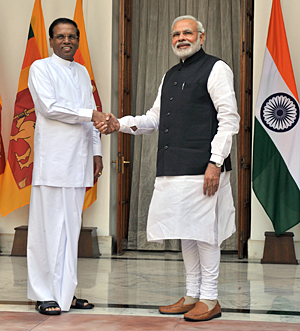INDIAN ARMED FORCES CHIEFS ON OUR RELENTLESS AND FOCUSED PUBLISHING EFFORTS

SP Guide Publications puts forth a well compiled articulation of issues, pursuits and accomplishments of the Indian Army, over the years

"Over the past 60 years, the growth of SP Guide Publications has mirrored the rising stature of Indian Navy. Its well-researched and informative magazines on Defence and Aerospace sector have served to shape an educated opinion of our military personnel, policy makers and the public alike. I wish SP's Publication team continued success, fair winds and following seas in all future endeavour!"

Since, its inception in 1964, SP Guide Publications has consistently demonstrated commitment to high-quality journalism in the aerospace and defence sectors, earning a well-deserved reputation as Asia's largest media house in this domain. I wish SP Guide Publications continued success in its pursuit of excellence.
President Sirisena’s visit and beyond
 |
By Lt. General P.C. Katoch (Retd) Former Director General of Information Systems, Indian Army |
Close on the heels of Sri Lanka’s Foreign Minister Mangala Samarveera’s ‘pilgrimage’ to New Delhi came the state visit by President Maithripala Sirisena to India starting today. If the visit was to boost bilateral relations between the two countries that had somewhat mellowed during the regime of former Sri Lankan President Mahinda Rajapaksa, it was highly successful. The Indo-Lanka relationship had soured post-2009 when Sri Lanka went back on promises for devolution of power to Tamils despite earlier setting up the Northern Provincial Council (NPC) after shooting his mouth off promising even greater autonomy than was envisaged in the 13th Amendment under the Indo-Sri Lanka Accord signed during Rajiv Gandhi’s tenure, under which thr IPKF was also sent to Sri Lanka. Rajapksa also went for heavily tilting towards China, even using this tilt brazenly as a bulwark against India. India then supported the US-backed human rights resolution against Sri Lanka at the UNHRC in Geneva. It was only when that resolution called for an international probe that India pulled back. More recently former Sri Lankan Foreign Minister Lakshman Kadirgamar had referred to Indo-Lanka relations as “irreversible excellence” and the Indian Prime Minister Narendra Modi just a few days ago had tweeted “the bonds of history, culture and shared values that we share are unbreakable”.

During President Sirisena’s visit, the two sides agreed to enhance bilateral cooperation between the two countries in fields of defence, energy, trade and investment sectors. A high point of the agreement was India sealing a nuclear energy agreement with Sri Lanka to help Sri Lanka build its nuclear energy infrastructure, including training of personnel. Later, India could also sell light small-scale nuclear reactors to Sri Lanka which wants to establish 600 MW of nuclear capacity by 2030. India's recent understanding with the US in peaceful uses of nuclear energy paved the way for the deal with Sri Lanka while Sri Lanka's readiness to sign the nuclear agreement is a breakthrough idering former President Mahinda Rajapaksa was against such deal. Acknowledging that India, Sri Lanka’s largest trading partner enjoys a huge trade surplus, Prime Minister Modi said that he supports a more balanced trade in both directions, adding that both countries are committed to unlock the vast potential of our economic cooperation. Major issues touched upon at the joint press conference during President Sirisena’s visit were: balanced trade between both countries; further improve air and sea connectivity between Sri Lanka and India; bilateral agreement on civil nuclear cooperation; satisfaction over progress in bilateral ties especially maritime security cooperation, including in the trilateral format with Maldives and Indian assisted projects for Internally Displaced Persons in Sri Lanka under which more than 27,000 houses have already been constructed; India's commitment to further develop partnership with Sri Lanka; accord highest importance to the fishermen issue and address fishermen associations on both sides; acknowledging that destinies of both countries are inter-linked with security and prosperity of both indivisible; expansion of cooperation in energy sector, both conventional and renewable; agreement to restart the long stalled discussions on the services sector in the upcoming commerce secretary-level dialogue, the current FTA between India and Sri Lanka not being presently applicable to the services sector; signing of MoU to enable Sri Lanka to participate in the Nalanda University Project, and: signing of an agreement on a Program of Cultural Cooperation to nurture cultural ties and promote contacts between people. The bilateral civil nuclear agreement is the first of its kind and it opens new avenues for cooperation, including in areas like agriculture and healthcare. Prime Minister Modi has accepted an invitation by President Sirisena to visit Sri Lanka in March and this visit should boost the India--Sri Lanka ties further.
There has been much in the news about Chinese investments in Sri Lanka but Sri Lanka does need investments and Sri Lanka is one country among many where China is using its economic power for strategic gains, given the mounting importance of the Indian Ocean Region. But the new government in Sri Lanka is assumed to not adopt an overtly pro-China policy, keeping India’s strategic interests in mind. While Prime Minister Narendra Modi will visit Sri Lanka in March on invitation of President Sirisena, the latter is also scheduled to visit China commencing March 26 to attend the annual Boao Forum for Asia. Chinese President Xi Jinping is due to inaugurate the forum, a prestigious Chinese think tank, modeled on the “Summer Davos” meet. The new Sri Lankan government is likely to continue with the Chinese infrastructure projects in Sri Lanka including the $1.5 billion Port City over which it has expressed reservations earlier. The Colombo Port City project is regarded as key for China’s new mega Maritime Silk Road project. Prime Minister Modi’s visit to Sri Lanka within a month of President Sirisena’s visit to India underlines the growing bilateral relationship between the two countries that would benefit population of both as well as the region.





